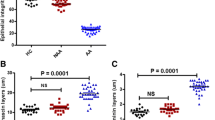Abstract
Vasomotor rhinitis (VMR) is a disorder of unknown pathogenesis. Forty patients with VMR were carefully selected on the basis of inclusion and exclusion criteria proposed by Mygind and Weeke. Nasal biopsy specimens were taken in the patient group as well as in a group of ten controls. Brush cytology was also taken in the VMR group. Inflammatory cells were identified and counted in the nasal mucosa, with the use of immunohistochemical techniques and a panel of monoclonal antibodies. Eosinophils were studied with the use of BMK13, EG2, and Giemsa. Mast cells were studied with anti-chymase (B7), anti-tryptase (G3) and toluidine blue. Sections were stained with IgE as well. There was no significant difference in the number of eosinophils, mast cells and IgE-positive cells between the two groups. Additionally, in contrast with other reports, in sections that were double-stained with anti-chymase and anti-tryptase, single chymase-positive cells were found.
Similar content being viewed by others
References
Borum P, Mygind N, Schulz Larsen F (1979) Intranasal ipratropium: a new treatment for perennial rhinitis. Clin Otolaryngol 4:407–411
Church MK, Okayama Y, El Lati S (1991) Mediator secretion from human skin mast cells provoked by immunological and non-immunological stimulation. Skin Pharmacol 4:15–24
Fokkens WJ, Vroon TM, Gerritsma V, Rijntjes E (1988) A biopsy method to obtain high quality specimens of nasal mucosa. Rhinology 26:293–295
Fokkens WJ, Godthelp T, Holm AF, Blom HM, Mulder PGH, Vroom TM, Rijntjes E (1992) Dynamics of mast cells in the nasal mucosa of patients with allergic rhinitis and non allergic controls: biopsy study. Clin Exp Allergy 22:701–710
Gerth van Wijk R (1991) Nasal hyperreactivity. Thesis, Rotterdam
Irani AA, Bradford TR, Kepley CL, Schechter NM, Schwartz LB (1989) Detection of MCt and MCtc types of human mast cells by immunohistochemistry using new monoclonal antitryptase and anti-chymase antibodies. J Histochem Cytochem 37:1509–1515
Jacobs RL, Freedman PM, Boswell RN (1981) Nonallergic rhinitis with eosinophilia (NARES syndrome). J Allergy Clin Immunol 67:253–262
Jones AS, Lancer JM (1987) Vasomotor rhinitis (editorial). BMJ 294:1505–1506
Jones AS, Lancer JM, Moir AA, Stevens J (1985) The effect of submucosal diathermy to the inferior turbinates on nasal resistance to airflow in allergic and vasomotor rhinitis. Clin Otolaryngol 10:249–252
Klementson H, Svensson C, Anderson M, Venge P, Pipkorn U, Persson CG (1991) Eosinophils, secretory responsiveness and glucocorticoid induced effects on the nasal mucosa during a weak pollen season. Clin Exp Allergy 21:705–710
Lacroix JS, Pochon N, Lundberg JM (1992) Increased concentration of sensory neuropeptide in the nasal mucosa of patients with non allergic chronic rhinitis. In: Motta G (ed) 2nd European Congress of Oto-Rhino-Laryngology and Cervico-Facial Surgery, 1992, Sorrento, Italy. Monduzzi, Naples
Mikaelian AJ (1989) Vasomotor rhinitis. Ear Nose Throat J 68:207–210
Mogbel R, Barkans J, Brandley BL, Durham SR, Kay AB (1992) Application of monoclonal antibodies against major basic protein (BMK-13) and eosinophil cationic protein (EG1 and EG2) for quantifying eosinophils in bronchial biopsies from atopic asthma. Clin Exp Allergy 22:265–273
Mullarkey MF (1988) Eosinophilic nonallergic rhinitis. J Allergy Clin Immunol 82:941–949
Mullarkey MF, Hill JS, Webb DR (1980) Allergic and nonallergic rhinitis: their characterization with attention to the meaning of nasal eosinophilia. J Allergy Clin Immunol 65:122–126
Ogale SB, Shah A, Rao SC, Shah KL (1988) Is vidian neurectomy worthwhile? J Laryngol Otol 102:62–63
Okuda M, Otsuka H, Kawabori S (1983) Basophil leukocytes and mast cells in the nose. Eur J Respir Dis 64 [Suppl 128]:7–14
Pipkorn U, Berge T (1983) Long-term treatment with budesonide in vasomotor rhinitis. Acta Otolaryngol (Stockh) 95:167–171
Selkin SG (1985) Laser turbinectomy as an adjunct to rhinoseptoplasty. Arch Otolaryngol III:446–449
Small P, Black M, Frenkiel S (1982) Effects of treatment with beclomethasone diproprionate in subpopulations of perrennial rhinitis patients. J Allergy Clin Immunol 70:178–182
Stjarne P, Lundblad L, Lundberg JM, Anggard A (1989) Capsaicin and nicotine-sensitive afferent neurones and nasal secretion in healthy human volunteers and in patients with vasomotor rhinitis. Br J Pharmacol 96:693–701
Tai PC, Spry CJF, Peterson C, Venge P, Olsson I (1984) Monoclonal antibodies distinguish between storage and secreted forms of eosinophil cationic peptide. Nature 309:182–184
Togias AG (1988) The osmolality of nasal secretions increases when inflammatory mediators are released in response to inhalation of cold dry air. Am Rev Respir Dis 137:625–629
Wachs M, Proud D, Lichtenstein LM, Kagey-Sobotka A, Norman PS, Naclerio RM (1989) Observations on the pathogenesis of nasal priming. J Allergy Clin Immunol 84:492–501
Wihl JA, Kunkel G, Middleton E (1985) Perennial rhinitis. In: Mygind N, Weege B (eds) Allergic and vasomotor rhinitis: clinical aspects. Munksgaard, Copenhagen, p 36
Wolf G (1988) New aspects in the pathogenesis and therapy of hyperreflexive rhinopathy. Laryngol Rhinol Otol (Stuttg) 67:438–445
Author information
Authors and Affiliations
Rights and permissions
About this article
Cite this article
Blom, H.M., Godthelp, T., Fokkens, W.J. et al. Mast cells, eosinophils and IgE-positive cells in the nasal mucosa of patients with vasomotor rhinitis An immunohistochemical study. Eur Arch Otorhinolaryngol 252 (Suppl 1), S33–S39 (1995). https://doi.org/10.1007/BF02484432
Received:
Issue Date:
DOI: https://doi.org/10.1007/BF02484432




